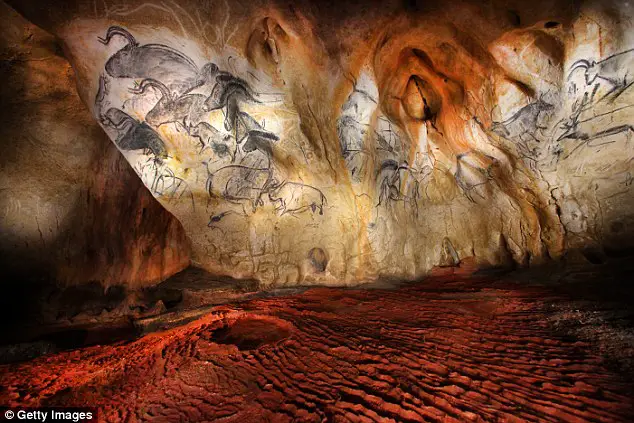Chauvet-Pont d'Arc Cave: Radiocarbon dating reveals incredible facts | Ancient Code

Radiocarbon dating has revealed several incredible facts about the Chauvet-Pont d’Arc Cave and human occupation dating back to around 37,000 to 33,500 years.
Researchers firmly believe that the prehistoric cave paintings of Chauvet-Pont d’Arc are among the earliest examples in the world, basically revealing an ancient snapshot of life, recorded by early humans who lived in the cave between 37,000 and 33,500 years ago.
Thanks to charcoal samples, scientists were able to conclude that the cave was occupied by human beings in two phases. The first phase last somewhere from 37,000 to 33,500 years ago and the second phase is believed to have last anytime between 31,000 to 28,000 years ago.
Thanks to new studies, experts have managed to create a timeline for the incredible site located in Ardèche, southern France, revealing when the cave was occupied and deserted both by humans and prehistoric ‘beasts.’
Discovered in 1994, the Chauvet-Pont d’Arc Cave features hundreds of incredible ancient paintings where ancient man drew at least 13 different animal species ranging from horses, cattle mammoths, cave lions, panthers, bears, rhinos and cave hyenas. The cave features a number human handprints as well.
Researchers were confused after their studies revealed the intricate order in which the cave paintings were made, showing that both animals and humans lived in the cave in the distant past.
According to scientists, old cave paintings were overlaid with other depictions, which itself bore marks created by prehistoric beasts, on top of younger artwork.
‘A bear scratch on top of a drawing indicates that humans no longer occupied the cave when the scratch was made,’ the experts wrote in the study, published in the journal Proceedings of the National Academy of Sciences.
‘Based on this information alone. However, we do not know how much older the underlying event is: thus the need to obtain absolute dates of parietal artworks.’
To work out the enigmatic data, and solve the mystery behind the marks in the Chauvet-Pont d’Arc Cave, a study led by Anita Quiles of the Institut Français d’Archéologie Orientale and Laboratoire des Sciences du Climat et de l’Environnement (LSCE) managed to compile over 250 radiocarbon dates, which were obtained by researchers over the last 15 years, ranging from charcoal pieces found, scattered across the cave’s floor, to charcoal drawings and countless markings left behind o the cave’s walls.
Full story at site

Radiocarbon dating has revealed several incredible facts about the Chauvet-Pont d’Arc Cave and human occupation dating back to around 37,000 to 33,500 years.
Researchers firmly believe that the prehistoric cave paintings of Chauvet-Pont d’Arc are among the earliest examples in the world, basically revealing an ancient snapshot of life, recorded by early humans who lived in the cave between 37,000 and 33,500 years ago.
Thanks to charcoal samples, scientists were able to conclude that the cave was occupied by human beings in two phases. The first phase last somewhere from 37,000 to 33,500 years ago and the second phase is believed to have last anytime between 31,000 to 28,000 years ago.
Thanks to new studies, experts have managed to create a timeline for the incredible site located in Ardèche, southern France, revealing when the cave was occupied and deserted both by humans and prehistoric ‘beasts.’
Discovered in 1994, the Chauvet-Pont d’Arc Cave features hundreds of incredible ancient paintings where ancient man drew at least 13 different animal species ranging from horses, cattle mammoths, cave lions, panthers, bears, rhinos and cave hyenas. The cave features a number human handprints as well.
Researchers were confused after their studies revealed the intricate order in which the cave paintings were made, showing that both animals and humans lived in the cave in the distant past.
According to scientists, old cave paintings were overlaid with other depictions, which itself bore marks created by prehistoric beasts, on top of younger artwork.
‘A bear scratch on top of a drawing indicates that humans no longer occupied the cave when the scratch was made,’ the experts wrote in the study, published in the journal Proceedings of the National Academy of Sciences.
‘Based on this information alone. However, we do not know how much older the underlying event is: thus the need to obtain absolute dates of parietal artworks.’
To work out the enigmatic data, and solve the mystery behind the marks in the Chauvet-Pont d’Arc Cave, a study led by Anita Quiles of the Institut Français d’Archéologie Orientale and Laboratoire des Sciences du Climat et de l’Environnement (LSCE) managed to compile over 250 radiocarbon dates, which were obtained by researchers over the last 15 years, ranging from charcoal pieces found, scattered across the cave’s floor, to charcoal drawings and countless markings left behind o the cave’s walls.
Full story at site
